1. Is it normal that the garden house has water marks and/or moisture stains?
Yes, after a long period of rain – or on the weatherside, water marks or moisture stains can be visible  . Therefore we recommend the following:
. Therefore we recommend the following:
- Apply 1 layer of stain to the inside walls of your garden house.
- Have a damp proof membrane [option] installed during the production process (post-insulation is possible).
- Place one or more ventilation grids!
- If you want, you can install OSB boards on the inside.
- Treat the outside with Nano Coating Pro Woodprotector or with a colour stain.



2. Is it normal that the windows and doors are jammed?
Jammed windows and doors can be fixed by loosening or fastening the adjustable hinges.
Adjust doors:

Push the door upwards by holding the handle until the door is released from the hinges. Use a screwdriver to adjust the hinges. Rotate one time anticlockwise in summer, and one time clockwise in winter. Repeat until the desired result is achieved.



Adjust windows and doors + lubrication of all moving parts. Ask our Christiaens Yvan team to do this for you at the current hourly rate and call-out charges.
For sliding doors:

For sliding doors adjust the height of the door at the rollers. It is also recommended to lubricate the door lock and the hinges at regular intervals. Wood treatment: every 2 years, you should apply an extra layer of stain (free colour choice) to the interior side of your wooden window frames and doors.

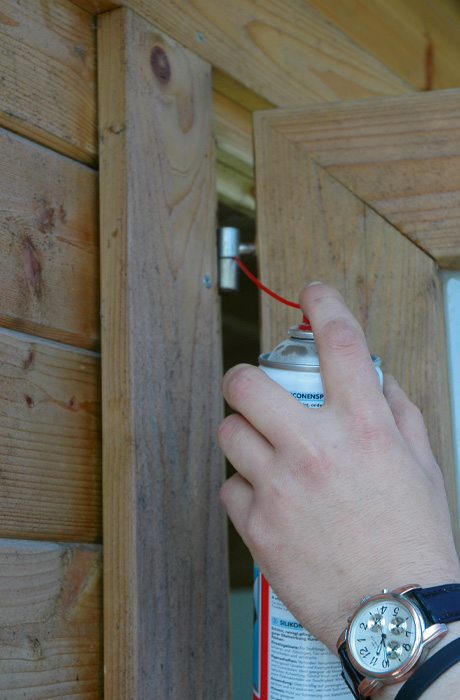





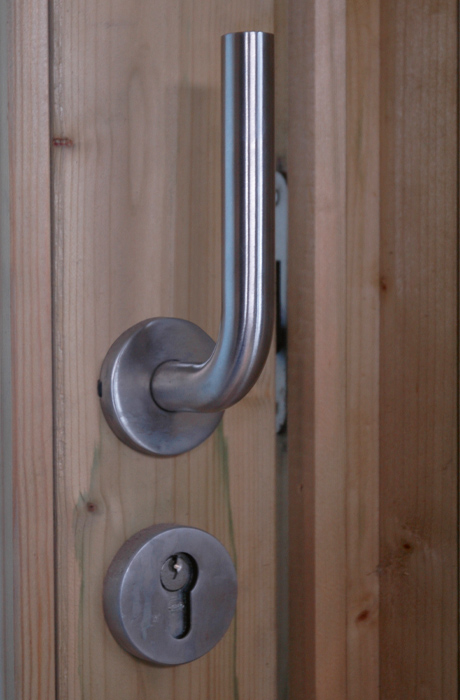
Adjust Cubusline doors:

Adjust the door by adding or removing the adjusting plate. To do so, you need to unscrew the hinge, add or remove the plate and reattach the hinge with the screws. In summer you add the plate and in winter you remove it. Repeat this procedure for each hinge.
Note:If simply adjusting the door by removing the adjustment plates is not sufficient, we recommend dehumidifying or at least ventilating your garden house. Preferably, we avoid planing the door. If we plane a door in winter to prevent it from jamming, it may no longer close properly in summer.

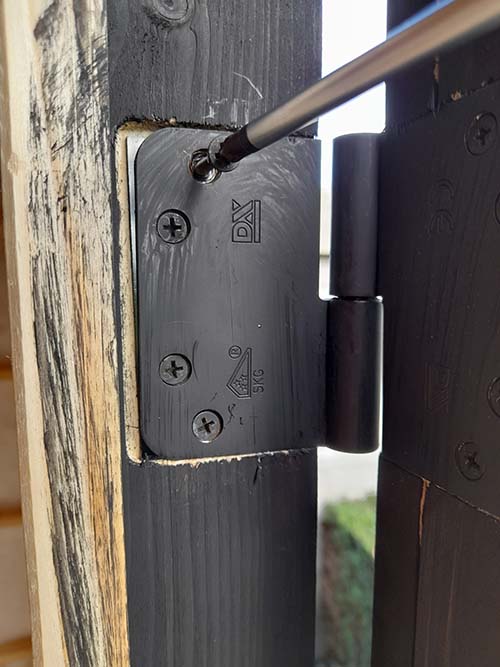








3. My Salt Green or Cosy Grey garden house has stains. Is that normal?
Wood in those colours was autoclave treated and needs time to dry. This drying process could take a few months to complete.

4. My garden house or wooden shed is moist.
This happens especially during winter. Good ventilation is very important, and a small construction dryer a or moisture absorber might work miracles.
Order your moisture absorber here in our webshop.
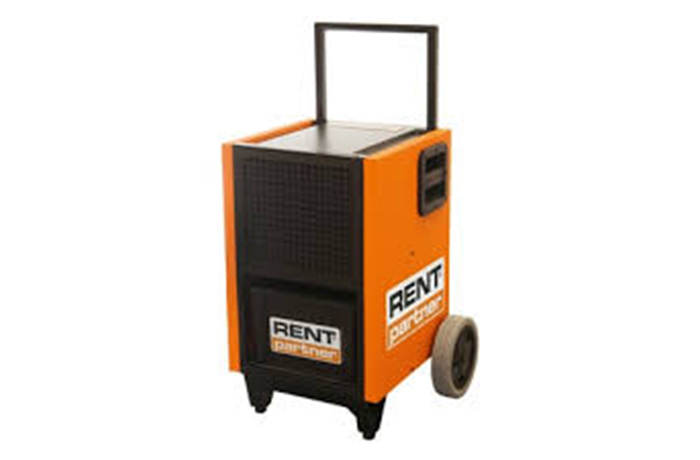

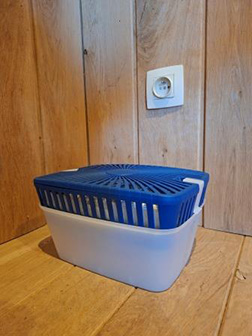
Because of the moist, window and door frames might expand, and subsequently get clamped. This can also happen right after the garden house is built, when the concrete slab has not completely dried out.
5. Is it possible that the boards of my garden house do not all have the same width?
Yes, whitewood is very sensitive to weather conditions such as moist (swelling), sunlight (shrinkage), and it can measure up to a few mm difference.
6. Is it normal that the flat roof edging is made of pieces with various lengths?
Yes, it exists of 2 or more pieces and there is no minimum nor maximum length. Along the full roof length and on the corners the eaves are fit into each other through aluminium profiles. However, the length of the eaves is made out of one piece. Through special gluing, a unique and beautiful result can be achieved.
7. When opening the packing of the supplied garden house, I see blue liquid. Is this normal?
This is indeed possible. After production, the entire garden house is autoclave-treated for a while, so all elements are pre-treated. Even though perforated packing is used, it might be that not all (blue-coloured) liquid has drained. This is, however, no problem and is particular to the production procedure.
8. Is it normal that, in summer, my door panels have gaps?
Yes, the production procedure considers maximum expansion (during winter). In summer, wood can shrink which might result in gaps. It is yet very easy to manually, without using any tool, shift the tongue and groove boards to close the gaps.

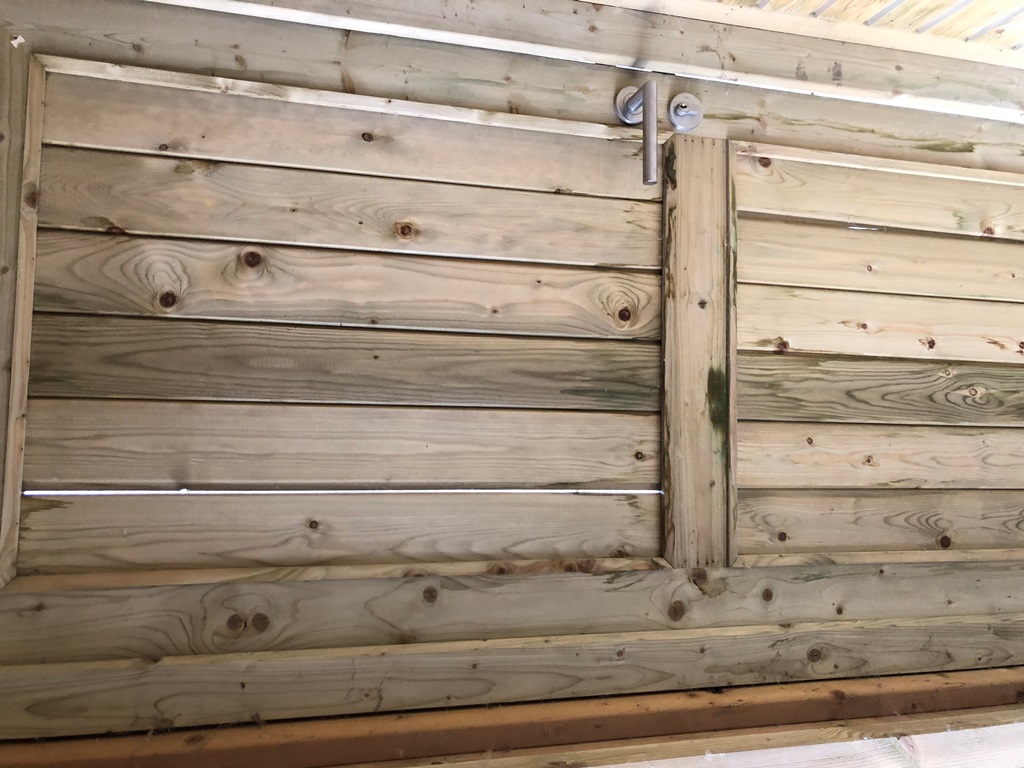

10. Is it normal that roof beams of autoclave garden houses are not fully sealed?
All parts are manufactured in our workshop, after which they are put under pressure in a container. Only by this procedure, the saw cut is treated. We try to consider shrinkage and expansion as much as possible beforehand, but sometimes there is a gap nevertheless. Such gaps are no disadvantage to the construction.

11. Is it normal that the outer walls of my Cedar/Oak/Iroko/Thermo ayous/Cosy Grey/Salt Green wood garden house are composed of boards with different lengths?
Yes it is, because we use all-round tongue and groove boards. They were specifically manufactured to cover industrial buildings, house fronts, etc. The easy to manoeuvre boards have been perfectly cut and milled in our production hall. After the cedar wood has weathered, the various lengths won’t be that visible and it shall not affect the strength of your garden house. On the contrary, the wood shall bend and move to a lesser extent.
12. Is it normal that the stainless steel nails in panel constructions are visible? Why are they not concealed?
Yes it is. 25 years ago, the boards where only fixed by hidden nails in the tongue and groove joints. Since wood naturally expands and shrinks (due to weather conditions), they got loose after a while. At Yvan Christiaens, boards are nailed in a concealed manner, and then nailed through the wood for extra solidity. Over time, these stainless steel nails become almost invisible.
13. Are cracks and fissures in the wood normal?
Wood is a natural product: in summer it shrinks, while in winter it expands. Shrinkage cracks, bows or dead knots are perfectly normal, also in laminated wood. Window and door hinges should therefore also be adjusted. Impregnation might result in marks, white deposit or faded parts. All of this is normal and inevitable. The construction’s strength shall not be affected by any of this.





14. Is the presence of resin glands normal?
Wood is a living material, both in storage and when being processed. Resin may ooze out of softwood; this is normal. If this bothers you, it can be removed with a wood chisel or with turpentine.

15. The boards have different colours, is that normal?
Each tree has its own tint. So a difference in colour is logical, even after staining. This will diminish, and may even disappear completely, over the course of time and with exposure to sunlight.

16. Is it normal for the roof board to have scratches on it?
The roof cladding can develop small scratches during handling. However, this will not affect the quality of the cladding. It will not rust!

17. Why is there a crack near the hinges of my garden house door?
A crack on the outer part of the door at approximately 5 cm from the hinges? If the door of your garden house is installed in a corner, a clumsy move or the wind can make the door flip over, causing damage such as a crack. This is no structural defect. Install a doorstop to prevent the door from opening over 180°.

18. There is small gap of a few mm at the top or bottom of the door. Is that normal?
Because wood expands and shrinks it is indeed possible that a gap shows at the top or bottom of the hinged doors of your garden house. The doors are tailored for use in a garden house or other wooden construction, and are only held back by the door lock in the middle. Despite a correct adhesion, the doors can slightly warp on the outer ends, and at the changing of the seasons a small gap can show.

19. There are stains on the autoclaved wood of my garden house. Is this normal?
The autoclave treatment can result in stains on the wood of garden houses and carports in Salt Green and Cosy Grey. These stains can easily be removed using methyl alcohol (for sale in any DIY store).
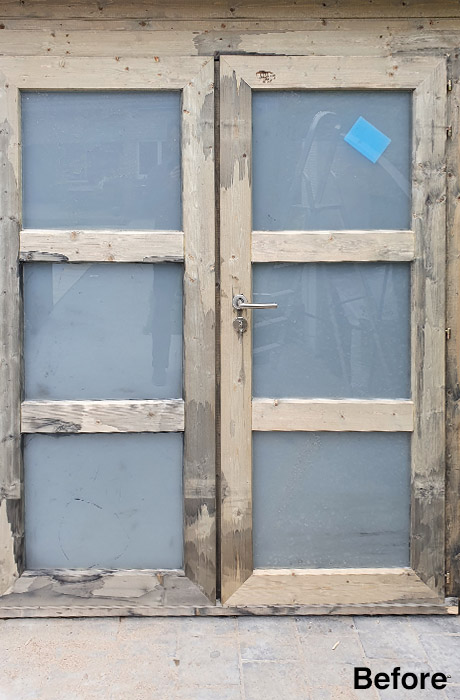

20. Could the silicone sealant of my garden house windows come loose after a certain time?
Yes, that is possible and perfectly normal. The silicone sealant is also exposed to diverse weather influences, and after a certain time, it will come loose and/or fall away. The solution? Add up with transparent paintable silicone sealant where necessary, or remove the old silicone sealant and replace it with a new transparent paintable one.
21. I see stains on my terrace after the unloading of the garden house or carport, or during the construction thereof. Is that normal?
Upon delivery, some wood types and also autoclaved wood may produce a fluid resembling blood. This is caused by moist. When it rains, particular substances are set free and come out of the wood. This might result in rusty stains on your stone terrace floor. The stains are not damaging and can be removed with terrace tile cleaner.




22. Is it normal that on a flat roof the eaves or edge boards or wall remain wet after rainfall?
Yes, an EPDM roof is always edged with an aluminium profile. When 2 of those profiles are connected by means of an intermediate piece, there will be a seam. For technical reasons, this seam is never sealed up with silicone. That is why after rainfall water marks on the eaves or on the walls can appear around this seam. This is completely normal, and will not affect the wood nor the garden house. See also factory buildings or houses.


23. There a damp patches on the inside of my garden house. Is that normal?
The windows and doors of our garden houses are equipped with a weep drainage system, which is either visible or invisible. During long and/or heavy rainfall this system might not be able to drain all water, leaving stains. This is normal and in accordance with the current standards for garden houses. The standards for this that apply to homes, are much stricter. You can treat the windows and doors with a water-repellent product, but you don’t have to because all possibly accumulated moisture will eventually dry up. There is sunshine after the rain.

24. There are stains on the windows and I can’t remove them by any means. Is this normal?
We recommend to clean all glass elements of windows and doors within 8 days after installation of the garden house, and not to leave them exposed to the sun!
This could cause penetration of lime and/or Cosy Grey or Salt Green products, which is indeed very difficult to remove. We recommend the use of acetone as a cleaning agent for glass.
25. Is it normal for door hardware to oxidize?
Garden houses are equipped with door hardware. Oxidation is normal after a few months but it won’t affect its operation. We recommend to treat all hinges and locks with WD40 (already in your possession).



26. Is it normal for my garden house to have dark stains or mould?
In our humid Belgian climate, discolouration and/or mould stains are absolutely normal. The wood shall not be affected by it. You can prevent mould by maintaining your garden house with hydro oil. But the best thing you can do, is to handwash the wood with a mixture of hot water and a bit of bleach; as it is applicable on floors, terraces, etc. Never use a high-pressure cleaner..


27. Is it normal that there is a little round hole in my garden house’s wood?
Yes, wood is a natural product that swells and shrinks under the effects of the weather. As a result of that, non-weathered knots can come loose. Those holes can easily be filled with wood paste in the colour of your choice (eg. Gupa Wood Filler), without any special material or knowledge being required. Moreover, such filling products are specifically developed to fill cracks, fissures and holes.


28. Mould on thermo ayous and other sustainable wood types: what to do?

After days or even months of rain, everything in the garden is moist, including your garden house. A couple of months later you see black spots, stains and patches on your garden house made of thermo ayous wood. What is this? Mould on new material? No, this is not a manufacturing defect, nor it regards a bad board. On the contrary: moulding on wood is a natural process, even on wood types such as thermo ayous! But what should you do now? Is your wood damaged? This blog post examines this phenomenon and answers all of your questions.
It is very natural to find mould on wooden garden furniture as well as on wooden garden structures. All wood types, including European wood, tropical hardwood and thermally treated wood are susceptible to moulding by nature. Thermowood, however, is known for its resistance against mould which reduces the risk but still not fully excludes it.
Some positive news
No need to panic when you see mould on your wood. Here are some positive news facts!
First of all, mould is only hazardous for the material’s sustainability and firmness in exceptional cases. That is when the mould thrives on the wood and thus takes nutrients out of the material. Bacteria on thermally treated wood (such as thermo ayous) get their nutrients out of the air so they do not damage the wood. No mould will make the wood rot.
Even though you should not worry about the material’s firmness, there is an aesthetic difference: you do see black spots or patches on the boards. However, this discolouration disappears by itself: stains will disappear over time as the wood ages. How long does it take for the wood to have sufficiently aged and you no longer see spots? That depends on the situation and could take up to a year.
Would you like to get rid of these spots sooner than that? Here are some simple solutions you could implement to treat the surface nevertheless. Undiluted cleaning vinegar, for instance, can improve the mould in an aesthetical way. Or mix 50 to 100 grams of soda with a bucket of water and scrub the spots using a non-metallic brush. Leave the product on for a short time. The acid in the vinegar and the soda mix kills algae and mosses. Then rinse with clean water and the spots will disappear. You could also use an antifungal product.
Where does this mould come from?
Mould is often the result of moist in wood. This could come from rain, a drainpipe above the wood, leaking pipelines between boards or a pond that is in direct contact with the wood. The saying ‘prevention is better than cure’ also applies to wood. So make sure there is enough ventilation or that the wood is not in permanent contact with stagnant water. Leaking pipelines should be repaired as quickly as possible. Wood that is not in direct contact with water, or that can completely dry after being wet, is not that sensitive to moulding.
Sometimes moulding occurs on garden walls or on the outside of particular garden structures. Whether or not a project is susceptible to it, depends on its location and orientation. There is an increased risk of mould in shaded places. Also, south-west facing garden screens are more often exposed to rain. Covered pieces of wood that occasionally get wet, dry out more slowly which makes them perfect sources for mould to form on.
Moulding especially happens in wooded places where surface fungal often occurs. In such places fungal spores more often travel in the air after which they fall onto the wood and settle on it.
The susceptibility of wood to mould also depends on how it is dried at the manufacturer’s. After a tree is cut and sawn into boards, the wood is dried. Thermally treated wood is then heated in a kiln. Both processes largely decrease the wood’s moisture content. The less moist, the lower the risk of moulding. So if mould develops, it might be that the boards were taken out of the kiln too soon, or that they were not heated at a temperature high enough.
One last factor that can play a role in this, is the wood type. Lighter wood types, such as ayous, are more susceptible to mould than (tropical) hardwood types, such as ipe and padauk.
Conclusion
There are different reasons why mould might form on your thermally treated wood. So the most important thing to remember is that moulding is a natural process that you usually do not expect but could encounter. Even though thermally treated wood is less susceptible to moulding than other wood types, it is still possible to see black spots, stains and patches over time. After a while they will vanish in the aged grey colour of the wood. Mould will not affect the sustainability of your wooden garden wall, facade or terrace, so you do not need to worry about that. If you do want to get rid of it, you could clean the wood with for instance cleaning vinegar.
This article (originally in Dutch) was fully copied from Passie voor tuinen en wonen (Belgian website on gardens and living) - 01 sep 2022.

29. When it’s raining heavily or not, water seeps into my garden house along a knot. Is that normal?
A knot in the wood is where the tree used to have a branch. Knots have a different rotation and also another hardness than the surrounding wood. So water can seep in through the knot. That’s why we recommend the use of more sustainable wood types or to install an anti-damp cloth (only available for more sustainable wood types).


